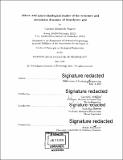Micro- and macro-rheological studies of the structure and association dynamics of biopolymer gels
Author(s)
Wagner, Caroline (Caroline Elizabeth)
DownloadFull printable version (31.88Mb)
Other Contributors
Massachusetts Institute of Technology. Department of Mechanical Engineering.
Advisor
Gareth H. McKinley and Katharina Ribbeck.
Terms of use
Metadata
Show full item recordAbstract
The cross-linked polymeric microstructures of biological hydrogels (or biogels) give rise to their mechanical properties, which in turn contribute to their proper biological function. For example, cartilage is stiff, elastic, and capable of withstanding substantial compressive forces in the knee, while saliva is thin, highly lubricious, and crucial for the maintenance of oral health. Quantification and modeling of the mechanical properties of these materials can provide insight into their microstructures, which is particularly important when structural changes are associated with impaired biological function. In this thesis, we use a combination of rheological testing and constitutive modeling to study this relationship between microstructure and mechanical properties in three biologically-relevant complex fluid systems. First, we explore the network structure and association dynamics of reconstituted mucin gels using micro- and macrorheology in order to gain insight into how environmental factors, including pathogens and therapeutic agents, alter the mechanical properties of fully-constituted mucus. We find that analyses of thermal fluctuations on the length scale of micron-sized particles are not predictive of the linear viscoelastic response of mucin gels. However, when taken together, the results from both techniques help to provide complementary insight into the structure of the network. For instance, we show that macroscopic stiffening of mucin gels can be brought about in different ways by targeting specific associations within the network using environmental triggers such as modifications to the pH, surfactant, and salt concentration. Additionally, by varying the size of the microrheological probe particles, we show that the disagreement between the rheological techniques on both length scales can be largely attributed to microphase separation and the presence of localized gel regions of varying stiffness. This finding is further supported through imaging techniques and direct visualization of the mucin network. As a second system, we study the temporal stability of saliva and its sensitivity to degradation in order to highlight the importance of considering sample age and enzymatic degradation when reporting extensional rheological measurements of saliva. Measurements show that the shear rheology of salivary mucin solutions (as measured by steady shear viscosity and small amplitude oscillatory shear (SAOS)) is quite insensitive to sample age over a 24 hour period following sample collection. By contrast, the filament thinning dynamics vary dramatically, with the characteristic relaxation time of the saliva and the breakup time of a fluid thread decreasing significantly with sample age. We interpret our results within the framework of a Sticky Finitely Extensible Network (SFEN) model which respects the known physical dimensions and properties of the mucin molecules in saliva, and models them as a network of physically associating and finitely extensible polymer chains. We show that the model can accurately capture the changes observed in the filament thinning dynamics with sample age by incorporating a steady decrease in the molecular weight of the supramolecular aggregates of mucin. As a third and final system, we develop a fractional calculus-based framework for improving the quantification of the mechanical properties of polysaccharide-based food solutions in order to facilitate the development of specific textures for liquid food consumption and for the design of dysphagia products. We demonstrate that fractional rheological models, including the fractional Maxwell model (FMM) and the fractional Jeffreys model (FJM), are able to succinctly and accurately predict the linear and nonlinear viscoelastic response of these food solutions and outperform conventional multi-mode Maxwell models with up to 50 physical elements in terms of the goodness of fit to experimental data. By accurately capturing the shear viscosity of the various liquid food solutions at a shear rate widely deemed relevant for oral evaluation of liquid texture, we show that two of the constitutive parameters of the fractional Maxwell model can be used to construct a state diagram that succinctly characterizes both the viscous and elastic properties of the different fluids. The experimental and theoretical tools employed to interpret the underlying microstructures of the biological fluids considered in these three studies are diverse, ranging from microrheological measurements to the adaptation and development of appropriate nonlinear polymeric constitutive models. As a result, the findings of this thesis should provide a starting point for interpreting the mechanical properties of a variety of complex fluids in a broad range of contexts. In particular, one application for which these techniques have already shown promise is in the emerging use of the material properties of physiological fluids as biomedical diagnostics. By continuing to develop analytical methods for improving the understanding of the relationship between rheology and biological structure, it is expected that these methods will be beneficial in studying the etiology and pathological basis for a number of medical conditions such as preterm birth and cystic fibrosis.
Description
Thesis: Ph. D., Massachusetts Institute of Technology, Department of Mechanical Engineering, 2018. Cataloged from PDF version of thesis. Includes bibliographical references (pages 191-205).
Date issued
2018Department
Massachusetts Institute of Technology. Department of Mechanical EngineeringPublisher
Massachusetts Institute of Technology
Keywords
Mechanical Engineering.